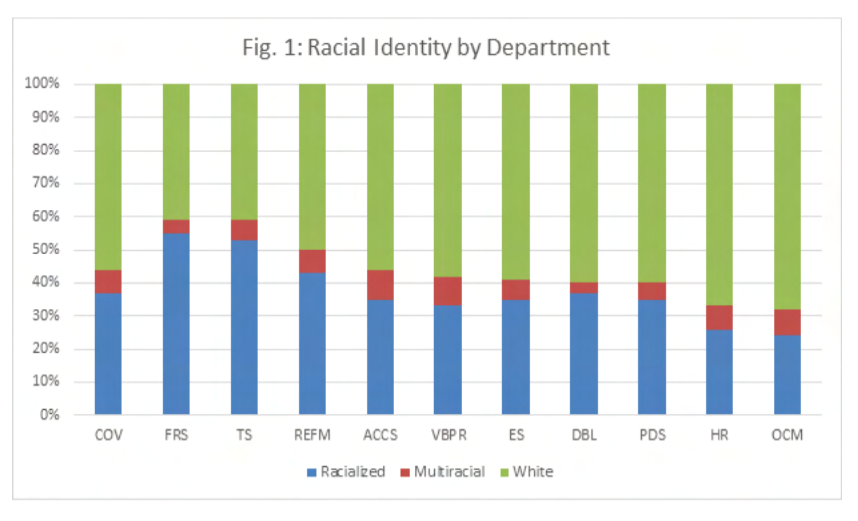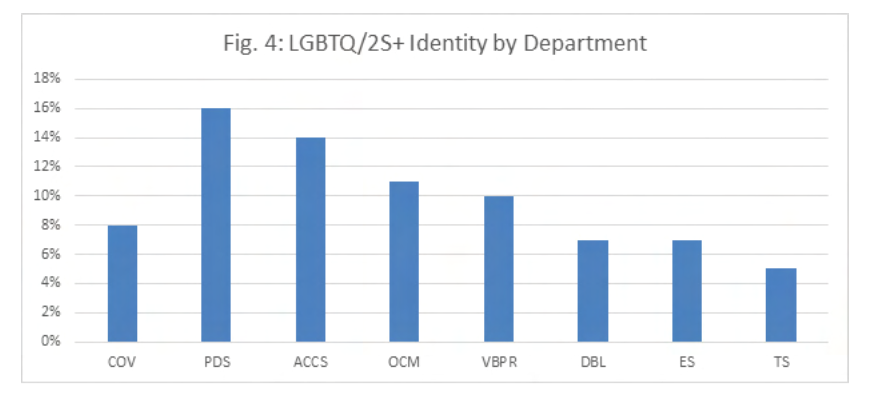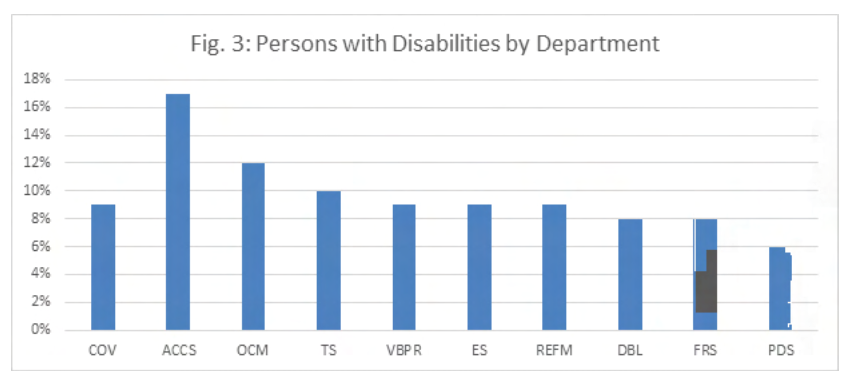A City of Vancouver employee survey has found that Indigenous and Black workers — along with people with disabilities and those who identify as non-binary, gender-fluid and trans — rated their experiences in the workplace lower than the average respondent on virtually every question asked.
The voluntary, confidential electronic survey administered by BC Stats on behalf of the city in the spring of 2021 received 3,732 responses from employees, a 55 per cent response rate, according to a memo from city manager Paul Mochrie.
“The finding confirms the need for targeted interventions to support these groups of staff,” said Mochrie in the July 25 memo, which has since been posted to the city’s website.
Vancouver Fire and Rescue Services, the Vancouver Police Department and Vancouver Public Library conducted similar and parallel exercises, but the results are not reflected in the data or provided in the memo.
Bullying and harassment
A report attached to the memo from Aftab Erfan, the city’s chief equity officer, said the survey asked two types of questions: a set of largely close-ended “demographic questions” inviting employees to self-identify and a set of “experience questions,” which asked respondents to indicate the degree of agreement with statements related to a sense of inclusion and belonging in the workplace.
“Indigenous staff reported lower experience scores for all 11 statements, usually 5-10 points lower than the city average,” the report said.
The greatest difference was in response to, “My work unit is free from discrimination, bullying and harassment,” where Indigenous workers indicated a score 13 points lower than the city average.
Black workers provided scores usually five to 10 points lower than the average for 10 of the 11 questions, the report said. Regarding access to culturally appropriate supports, Black staff indicated an average score 16 points lower than the city average.
Some of the other statements graded by respondents included:
• “I am confident that appropriate action will take place when I report an incident of discrimination or harassment.”
• “I feel that senior leadership in my department is serious about creating a fair and inclusive workplace”
• “The city creates opportunities for me to thrive in my career.”
• “Diversity in language, ability, accent, dress, lifestyle and physical appearance is fully appreciated in my workplace.”
The report noted that “divisional and team results,” which were not included in the report, indicate that workplace experiences “are troubling in some units [e.g. where there are unreported or unresolved cases of bullying] across all identity groups.”

44 per cent racialized, multiracial
The report noted racial makeup varies widely among departments.
Human resources and the city manager’s office have the lowest proportion of racialized and multiracial staff at just over 30 per cent, while finance and technology services have the highest proportion at nearly 60 per cent.
Across the organization, 44 per cent of respondents identified as racialized or multiracial. That percentage is higher in temporary full-time workers (53 per cent), regular part-time (46 per cent) and auxiliary positions (49 per cent).
The report warned that where results for an identity group appear lower or more negative than others, that “those results reflect the city’s shortcomings in making the workplace work for the identity group — it does not reflect the shortcomings of the identity group and should not be used to stereotype or stigmatize any group of staff.”
The number of non-binary or gender-fluid respondents — as well as self-identified trans respondents — were “too small in each department to be meaningfully compared” to the overall data.
“The representation may be assumed to be around the city average of one per cent,” the report said. “In parks and recreation, non-binary and gender-fluid persons made up about two per cent of respondents.”
At the organizational level, nine per cent of respondents identified as having a disability. The proportion ranges from 17 per cent of respondents in arts, culture and community services to about six per cent in planning, urban design and sustainability.

'Feeling relatively unsafe'
In identifying gaps in experiences of workers, the report includes recommendations to address employee concerns.
For example, several identity groups – those with trans experience, those identifying as non-binary or gender-fluid and those with disabilities – reported “feeling relatively unsafe” speaking with their managers if something inappropriate or uncomfortable happens to them in the workplace.
The response from the city: “As the city revamps its anti-harassment policy and procedures, additional safe-disclosure measures and channels should be considered. Manager training and development should prioritize ensuring that issues faced by trans, non-binary and disabled communities are well understood, and that managers have the literacy and sensitivity to create safety for conversations involving these aspects of identity.”
To the finding that racialized people are under-represented in human resources and the city manager’s office — “two departments that have a critical role and disproportionate impact in ensuring the wellbeing of city staff” — the report recommends hiring racialized people should be a priority for the two departments.
“While these examples are offered for illustration purposes, the process of integrating the messages from data into action should become a natural part of how the city operates,” the report said.

Some of the survey’s other findings:
• Indigenous representation among respondents was highest in arts, culture and community services at five per cent, and in parks and recreation at four per cent, compared to the city-wide two per cent.
• CUPE 1004 in particular has a low proportion of staff who identify as racialized (26 per cent) or multiracial (six per cent) in engineering, and 11 per cent and seven per cent in parks. CUPE 15 parks and recreation has a slightly above average representation of Indigenous staff at four per cent.
• Staff identifying as LGBTQ/2S+ varies from 16 per cent in planning, urban design and sustainability to five per cent in technology services. The results for several departments were suppressed as there were fewer than 10 responses in this category. The city-wide representation for this group is around eight per cent.
• Women’s representation ranges from under 30 per cent in engineering services and real estate and facilities management to more than 75 per cent in human resources and the city manager’s office.
• Six per cent of CUPE 1004 respondents identified as women in engineering and 13 per cent in parks and recreation. The proportion of men and women was about even among CUPE 15 respondents.
• Women respondents were over-represented among temporary full time (59 per cent), regular part-time (62 per cent) and auxiliary positions (50 per cent). Non-binary and gender-fluid respondents were over-represented among auxiliary staff at two per cent.
• Within CUPE 1004, 15 per cent of engineering staff and 16 per cent of parks and recreation staff identified as having a disability, which is notably higher than the organizational average of nine per cent. For CUPE 15, representation of staff with disabilities was similar to the city average.
• Staff who identify as having a disability is higher among auxiliary staff (12 per cent) and significantly higher among part-time staff (20 per cent).
• LGBTQ/2S+ staff are highly represented amongst CUPE 1004 staff in parks and recreation (14 per cent), as well as staff in auxiliary positions (13 per cent).
@Howellings


